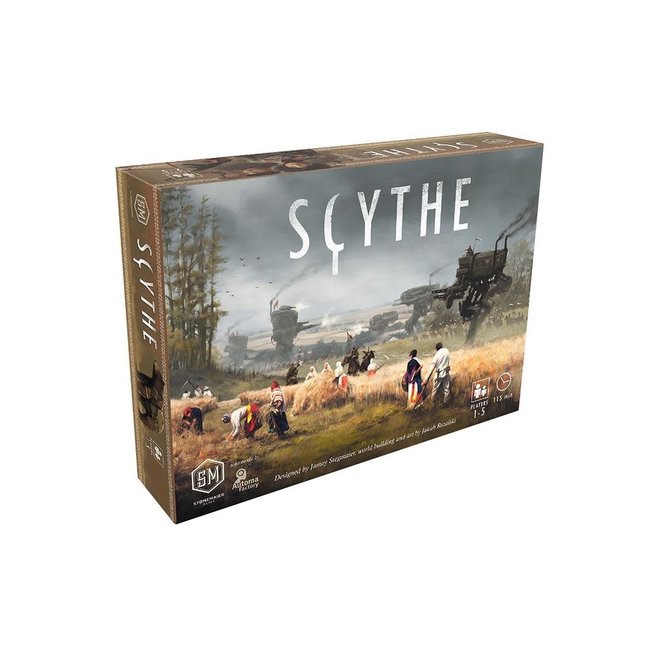Scythe is an engine-building, asymmetric, competitive board game set in an alternate-history 1920s period. It is a time of farming and war, broken hearts and rusted gears, innovation and valor.time of farming and war, broken hearts and rusted gears, innovation and valor.
Created by lead designer Jamey Stegmaier with the assistance of Morten Monrad Pedersen (solo variant) in the stark but beautiful world of artist Jakub Rozalski, Scythe successfully funded by Stonemaier Games via Kickstarter from October 13-November 5 and was released in August 2016. You can follow the progress of the game on BGG.
Card sizes (for sleeves; this includes all cards in the Kickstarter versions):
44x67mm: 42 cards
57x87mm: 58 cards
70x110mm: 64 cards
***
It is a time of unrest in 1920s Europa. The ashes from the first great war still darken the snow. The capitalistic city-state known simply as “The Factory,” which fueled the war with heavily armoured mechs, has closed its doors, drawing the attention of several nearby countries.
Scythe (1-5 players, 115 minutes) is a board game set in an alternate-history 1920s period. It is a time of farming and war, broken hearts and rusted gears, innovation and valor.
In Scythe, each player represents a fallen leader attempting to restore their honour and lead their faction to power in Eastern Europa. Players conquer territory, enlist new recruits, reap resources, gain villagers, build structures, and activate monstrous mechs.
Each player begins the game with different resources (strength, victory points, movement capabilities, and popularity), their choice of several faction-specific abilities, and a hidden goal. Starting positions are specially calibrated to contribute to each faction’s uniqueness and the asymmetrical nature of the game.
Scythe gives players almost complete control over their fate. Other than each player’s individual hidden objective cards, the only elements of luck are encounter cards that players will draw as they interact with the citizens of newly explored lands and combat cards that give you a temporary boost in combat. Combat is also driven by choices, not luck or randomness.
Scythe uses a streamlined action-selection mechanism (no rounds or phases) to keep gameplay moving at a brisk pace and reduce downtime between turns. While there is plenty of direct conflict, there is no player elimination, nor can units be killed or destroyed.
Every part of Scythe has an aspect of engine-building to it. Players can upgrade actions to become more efficient, build structures that improve their position on the map, enlist new recruits to enhance character abilities, deploy mechs to deter opponents from invading, and expand their borders to reap greater types and quantities of resources. These engine-building aspects create a sense of momentum and progress throughout the game. The order in which players improve their engine adds to the unique feel of each game, even when playing one faction multiple times.
1–5 Players (4 Players recommended)
Playing Time: 90–115 Min
Age: 14+
Complexity: Medium
Designer: Jamey Stegmaier
Artist: Jakub Rozalski
Publisher: Stonemaier Games

C$109.99